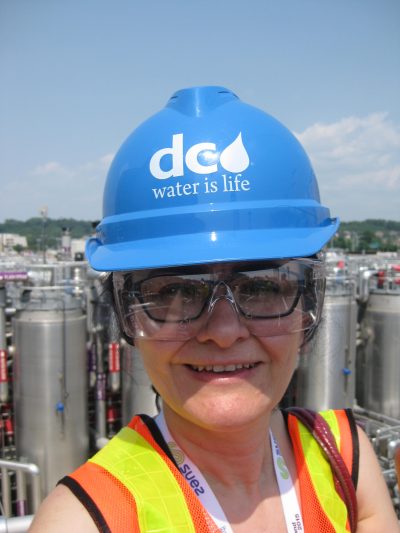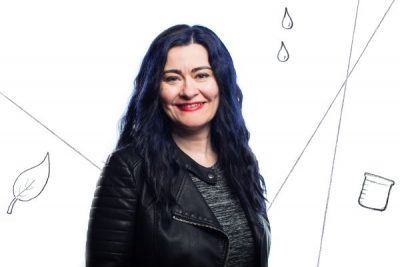 Banu Örmeci, Department of Civil and Environmental Engineering
Banu Örmeci, Department of Civil and Environmental Engineering
By Ariel Root
As a frightening mixture of pathogens, organic materials, heavy metals, gases, pesticides, pharmaceuticals and other chemicals, wastewater requires specialized facilities and techniques to properly and sufficiently remove these contaminants, and then manage the removed wastes. While the goal in developing new engineering techniques for wastewater treatment is to remove these contaminants, the system must be applicable to big treatment plants, as well as small treatment systems in remote and rural communities—and that can be a challenge.
Banu Örmeci is a Professor in the Department of Civil and Environmental Engineering, and a Canada Research Chair in Wastewater Treatment Engineering. Her research aims to improve and develop the design and performance of treatment processes in order to clear pathogens and contaminants from wastewater and sludge, so they do not pose a threat to public health or the environment.
Örmeci’s interests have a wide application, including treatment development and treatment optimization. Having studied the fundamental processes involved in wastewater treatment, Örmeci thoroughly understands the fate of pathogenic and chemical contaminants before, during, and after the treatment processes. “Wastewater treatment is not only about removing pathogens and chemicals from wastewater; it’s also about understanding their impacts on the environment if they are discharged to the environment in small quantities in wastewater effluents”. Chlorine is the cheapest and most widely used method of disinfection in North America but it does produce disinfection by-products that are harmful.  Alongside application of ultraviolet light based disinfection to eliminate the chlorine byproducts, Ormeci works on alternative disinfection methods that can safely destroy harmful microorganisms. Some of Örmeci’s research strives to improve the performance of such current processes, as well as develop new technologies that will achieve similar treatment results, but reduce operational costs.
Alongside application of ultraviolet light based disinfection to eliminate the chlorine byproducts, Ormeci works on alternative disinfection methods that can safely destroy harmful microorganisms. Some of Örmeci’s research strives to improve the performance of such current processes, as well as develop new technologies that will achieve similar treatment results, but reduce operational costs.
One such development was her investigation of an environmentally-friendly and cost-effective wastewater treatment process using microalgae that could grow naturally while cleaning out nutrients and contaminants. Örmeci acknowledges, that the “unique circumstances of Canada requires that simple and effective treatment processes are developed for communities in the North. What works well in Ottawa or Toronto doesn’t [always] work well in small and rural communities especially in cold and remote regions.” Partnering with industry has helped her advance new products, and explore new applications in Canada and abroad.
Working with industry and municipalities, Örmeci says that often partners “approach [her] with a problem that they need help solving…This real-world research is exciting, and important,” she says. “It’s engineering but it’s also directly related to public health and environment, so there are many relevant applications, and there is a high demand.” Örmeci has two U.S. patents and six pending international patents, and another commercialization on its way by one of the largest multi-national companies in the wastewater industry. “My research has been patented, licensed and commercialized; it’s very rewarding to see something that was developed in our lab be used at full scale in a treatment plant.”
 But for Örmeci, the goal is not always a patent. In May 2016, Örmeci was named the recipient of the 2016 Partners In Research (PIR) Engineering Ambassador Award. In addition to her fundamental and industrial research, she is a dedicated educator and mentor, organizing outreach events to promote and encourage the participation of women in science and engineering fields. Örmeci is the Faculty Advisor of the Carleton University Women in Science and Engineering (CU-WISE) group that is responsible for organizing events, camps, or panels, in high schools and at Carleton to help young women through support, advice, and camaraderie.
But for Örmeci, the goal is not always a patent. In May 2016, Örmeci was named the recipient of the 2016 Partners In Research (PIR) Engineering Ambassador Award. In addition to her fundamental and industrial research, she is a dedicated educator and mentor, organizing outreach events to promote and encourage the participation of women in science and engineering fields. Örmeci is the Faculty Advisor of the Carleton University Women in Science and Engineering (CU-WISE) group that is responsible for organizing events, camps, or panels, in high schools and at Carleton to help young women through support, advice, and camaraderie.
Aligned with the PIR’s mandate, Örmeci recognizes the importance of educating the public about the important and significant research within the science and engineering domains. “Knowledge mobilization is not just about doing the research, but also about translating the research results to public and practitioners and generating the products that can benefit the Canadian economy. The society should ideally benefit from the research.”
“I like doing different things. I like the variety, and the challenge; different techniques, different areas, different projects… [but] time is always a bottleneck.” Örmeci has no intentions of slowing down, as she continues to lead engineering research through developments and design, as well as ongoing outreach and education that will benefit Canadians.
For Dr. Örmeci’s contact information, go here.